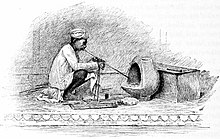This is an old revision of this page, as edited by 124.123.250.238 (talk) at 05:19, 30 August 2015 (→See also). The present address (URL) is a permanent link to this revision, which may differ significantly from the current revision.
Revision as of 05:19, 30 August 2015 by 124.123.250.238 (talk) (→See also)(diff) ← Previous revision | Latest revision (diff) | Newer revision → (diff)
Sunar (alternately Suniar(eh), Sonar or Swarnkar) is a Hindu Mair Rajput caste in India and Nepal referring to the community of people who work as goldsmiths. Though the community is primarily Hindu, some members in the states of Haryana and Punjab are Sikh Though They Belong To Kshatriya Dynasty They Calls Themselves As Mair Kshatriya Or Mair Rajput
Though they are the traditional goldsmiths of North India, now many are also landowners, involved in cultivation, as well as selling grocery. But their main occupation remains the manufacture and selling of jewellery. Members of the community are also involved in pawnbroking and moneylending. Gold work(not shudra) is ranked with iron work & untouchables in Manusmriti.
Etymology
The term Sunar may derive from the Sanskrit suvarna kār, "worker in gold".
Status in society

In Haryana, Sunars are divided into two segments, the Hindu Sunar and the Sikh Sunar. These two groupings are further divided into the Baari Sunar and the Shudre Sunar. Some Khatris also adopted this occupation and were called Khatri Sunars. All these groups are strictly endogamous, and practice clan exogamy. These divisions are further divided into clans, known as gotras. There are said to be fifty two gotras within the Sunar community. Some of them are the Gund, Bhole, Kuhal, Vaid, Mai, Bhulan, Odhera, Naali, Deo, Masoun, Vatash, Kushal, Kashyap, Dhir, Turar, etc. They believe themselves to be Kshatriya. The Sunar are still involved in their traditional occupation, that is being goldsmiths. There is however a steady process in taking up other occupations, and the community in Haryana as whole is fairly successful, having produced several professionals.
Factions
The Sunars are divided into a large number of territo rial and non-territorial groupings called alla. Some of the major alla are the Santanpuriya, Dekhalantiya, Mundaha, Bhigahiya, Samuhiya, Chilliya, Katiliya Kalidarwa, Naubastwal, Berehele, Gedehiya, Shahpuriya, Mathureke Paliya and Nimkheriya. Each lineage is associated with a particular area. To which its ancestors belonged to. The Sunar use Soni, Seth, Swarnkar,Singh, Shah, Bhutani, Sonik, Bagga, Babbar,chauhan, Verma, singh nagvanshi etc. as their surnames. In Gujarat and Rajasthan, the community is also known as Soni. In Harayana, the Sunars are often known as Swarnakar, Soni and Verma, are their common surname.
Sub-groups
- Khudabadi Sindhi Swarankar: Historically associated with the Sindh region of modern Pakistan prior to the Partition of India, and the city of Khudabad as well as city of Hyderabad.
See also
References
- People of India: Uttar Pradesh (Volume XLII) edited by A Hasan & J C Das page 1500 to 150
- People of India: Uttar Pradesh (Volume XLII) edited by A Hasan & J C Das page 1503
- R.V. Russell (October 1995). The Tribes and Castes of the Central Provinces of India. Vol. IV. Published Under the Orders of the Central Provinces Administration, Macmillan and Co., Limited St. Martin's Street, London. 1916. p. 517. Retrieved 6 July 2011.
- People of India: Haryana (Volume XXIII) edited by M.L Sharma and A.K Bhatia pages 475 to 479 Manohar Books
- People of India: Uttar Pradesh, in madhaya pradesh (nagvanshi)kshatriya sonar (Volume XLII) edited by A Hasan & J C Das page 1500
- People of India: Haryana (Volume XXIII) edited by M.L Sharma and A.K Bhatia page 475 Manohar Books
- G.S. Purswani. Incredible Origin and History of Khudabadi Sindhi Swarankar Community. Jaipur, India 5 November 2005
Further reading
- R.K. Gupta, S.R. Bakshi. Studies In Indian History: Rajasthan Through The Ages The Heritage Of Rajputs (set Of 5 Vols.). Sarup & Sons, 2008. ISBN 81-7625-841-5, ISBN 978-81-7625-841-8
Categories: